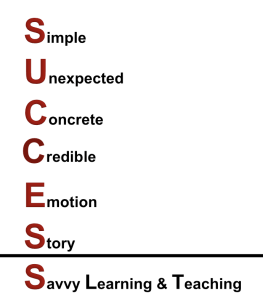Active learning is NOT associated with student learning, according to recent research published by the American Society of Cell Biology.
Not an assertion you were expecting us to feature?
Nope. So, do read on, letting this unexpected bit of information unwind:
The ability to gain and keep people’s attention is essential to teaching. In their book, Made to Stick, Chip and Dan Heath suggest a number of methods for gaining and keeping your students’ attention. One approach for gaining attention is to break the expected pattern of starting a class. For instance, a typical large statistics class might begin with an instructor saying, “In today’s class, I’d like to cover the topic of probabilities. Let’s start with the pigeonhole principle.
However, an unexpected way to start the same class might begin with the instructor saying: “All right, let’s make a wager. I’m willing to bet that at least two people in this lecture hall share a birthday. If you don’t believe me, then make a bet of a dollar and if there aren’t at least two people in this room who don’t share a birthday, I’ll pay each of you two dollars.”
While taking money from one’s students may not be ethical (and most certainly does not reflect an endorsement by the author of this posting, the Center for Teaching and Learning or the University of Minnesota), starting a statistics class with the birthday paradox will get their attention.
A technique for keeping attention is to make people curious, perhaps by using cognitive disequilibrium to highlight a counterintuitive finding, like, for instance, research that asserts that active learning methods don’t work. So, why in the classrooms studied and in similarly contexted classrooms did active learning strategies not lead to more student learning? First, some background on the study:
Drawing on a sample of 33 different instructors from 28 schools and more than 8,000 students, the article authors (citation and link to article below) assessed beginning of the term pretests and end of the term posttests to assess how much students had learned about natural selection in introductory college biology classes. Instructors of the related courses provided lists of the types of active learning exercises that they used and the frequency with which they used them.

Analyzing the data gathered, the researchers did not find an association between the frequency of active learning exercises and how much students learned about natural selection. In short, giving students lots of clicker questions or asking them to participate in think-pair-share activities on its own did not lead to more learning.
So does that mean that we should use a chalk-and-talk approach to teaching?
No.
What the authors advocate is a more careful and deliberate use of active learning since those who say that they use active learning in their classrooms are not necessarily effective in using active learning as a pedagogic strategy. For instance:
- An instructor may use active learning strategies in her/his classrooms but only solicit one answer from the class, thereby failing to expose students to a range of ideas from students.
- Or, the instructor may not provide sufficient time for students to process their thoughts.
- The instructor may also simply misuse a technique, even a “simple” one like think-pair-share: one study cited suggests that 63.5% of instructors reported using the technique but 83% of those who used it did not used it as suggested by the researchers.
The article also recommends using not only more pretest/posttest assessments to assess overall effectiveness, but also more formative assessments to measure ongoing learning. Finally, the authors recommend that teachers directly confront students’ preconceptions about content, since those preconceptions can interfere with learning new material. The authors’ decision to test students’ knowledge of natural selection is particularly apt because students are more likely to benefit from engaging and processing in such a difficult and long misunderstood topic.
However, if instructors do not directly address students’ preconceptions, students are unlikely to be able to transfer and apply that knowledge in an accurate manner, hence the lack of improvement in their posttest results.
As the authors conclude, “Simply adding clicker questions or a class discussion to a lecture is unlikely to lead to large learning gains. Effectively using active learning requires skills, expertise, and classroom norms that are fundamentally different from those used in traditional lectures.” Instructors therefore need to be savvy in making course planning decisions about why and how as well as when and in what ways to apply active learning approaches to their teaching; otherwise, they may very well be investing a significant amount of time and effort in deploying these strategies in ways that do not lead to animating and deepening student learning.
Resources
- Andrews, Leonard, Colgrove, and Kalinowski. “Active Learning Not Associated with Student Learning in a Random Sample of College Biology Courses.” CBE – Life Sciences Education 10.4 (1 December 2011): 394-405.
- SUCCESS in Teaching – Simply an Introduction and a First Principle – http://wp.me/p1Mdiu-9X
Pigeons in flight photo by Danko Dubric; used via Creative Commons ShareAlike/Attribution License.





I am finding the same thing, and I wonder if the discussion on learning should focus more on conceptual change rather than active learning.